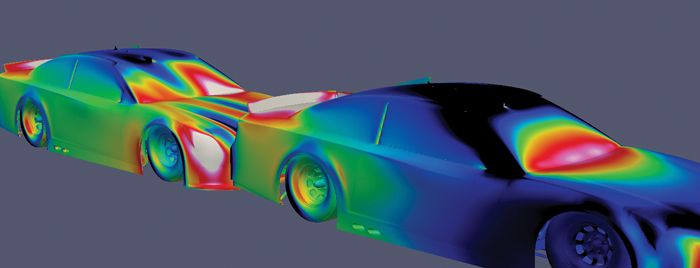Drive a car not originally built for racing around an oval track at about 200 miles per hour for a couple of hours and you should begin to understand why stock car drivers would want the latest and greatest information on things, such as how their car will handle in close traffic on a banked curve.
Eric Jacuzzi, an aerodynamics and vehicle performance engineer at the R&D Center for the National Association for Stock Car Auto Racing, commonly known as NASCAR, has turned to the Ohio Supercomputer Center (OSC) to help drivers better understand performance factors that must be controlled to keep them competitive and safe.
“NASCAR has always realized the importance of aerodynamics, with specific sets of rules for the various tracks that the series runs on,” said Jacuzzi in an article for the U.K. magazine Racecar Engineering. “Understanding the aerodynamic behavior of the cars in traffic is crucial to ensuring the cars do not become overly aero sensitive and limit the racing quality.”
NASCAR first dove into leveraging computational fluid dynamics (CFD) in 2012, turning for assistance to TotalSim USA, an engineering services provider in Dublin, Ohio. TotalSim is a stalwart partner of OSC industrial engagement programs and possesses valuable CFD experience in every professional racing series in motorsports.
“Eric was trained by TotalSim on our software stack and OSC usage so he can now operate independently with only occasional software and other support from TotalSim,” said Ray Leto, president of TotalSim.
Jacuzzi performs most of his work through a TotalSim-customized version of the open-source CFD software package OpenFOAM, designing grids of 50–120 million polyhedral cells for a single car run. A recent study featured a stationary lead car with a second car in a variety of trailing positions. Jacuzzi performed a series of 46 simulations that generated 500 gigabytes of data. The study yielded important clues on a myriad of racing and competition-related issues, such as drag advantage, cornering performance, underbody downforce deficit and sideforce loss.
“NASCAR will continue to work on improving car aerodynamics, while considering what magnitudes of forces work best at specific tracks and for tire supplier Goodyear,” Jacuzzi said. “... continuing on the path of scientific analysis and attacking the problem analytically will ultimately yield the best result for fans, drivers and the series as a whole.”
Project Lead: Eric Jacuzzi, National Association for Stock Car Racing
Research Title: Sprint Cup car's aerodynamic characteristics both alone and in traffic, based on extensive mapping of multi-car CFD runs
Funding Source: NASCAR R&D Center
Website: linkedin.com/pub/eric-jacuzzi/8/894/99a

